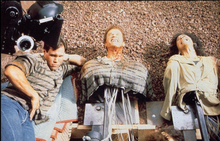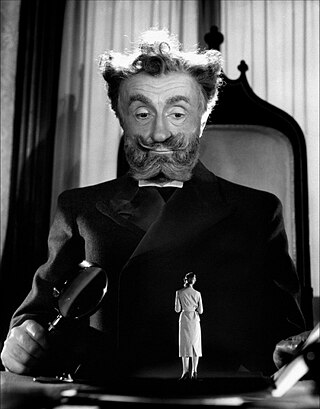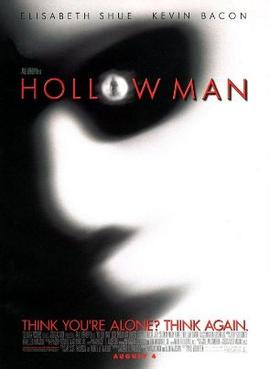Creature effects and prosthetics
Bottin had been asked to work on the film while it was being developed by De Laurentiis, but chose to work on the horror film The Thing (1982). [5] When Verhoeven developed Total Recall's creature effects, he wanted to avoid the criticism he had received for the violence and gore of RoboCop. He and Bottin agreed to focus on malformed, stretched flesh instead of blood, [15] but over 3,000 blood packs were still used in the film; [3] many of the more-complex makeup effects were executed in post-production. [16] Bottin and his studio were responsible for the creature effects. [17]
Decompression scenes

To depict the effects of decompression in the Martian atmosphere, Bottin made molds of Schwarzenegger, Ticotin and Cox by applying latex to their faces as they made exaggerated expressions. The resulting molds were used to create masks to which Bottin added small air pockets which could be filled to further distort their features. [18] About designing the masks, Bottin said: "If the eyes are going to come out and the tongue is going to come out, how does it come out? Does it come out and fall down? Does it come out and move? Does it twist? Does it go up and lick the eyebrows? Does it fall down to the stomach? How does the neck move if the tongue is doing that? What are we going to do with the eyes if the tongue and neck are in the way?" [15]
Four heads were made: one each for Schwarzenegger and Ticotin, and two for Cox. Schwarzenegger and Ticotin's heads were fully articulated, with manually-operated cables controlling swelling tongues, foreheads, cheeks and eyes. The eyes had sculpted muscles and tendons attached to the back, and were lubricated to slide easily out of their sockets. Instead of using air bladders to swell sections of the heads, full-size head- and torso-shaped bladders were constructed and stretched out over a mechanical skeleton; they had smaller air bladders at specific points, which Bottin thought made the bladders appear to be "fighting each other." [19] For one of the Cox heads, rigid veins were laid in the mold and floated on pins to give the finished mask veins beneath the surface where the skin stretched. The other head had a protruding tongue and eyes which emerged fully from the head. The air bladders were inflated by people blowing into pipes, providing a more natural movement than mechanical bellows. [16] Bottin's crew studied video footage of the actors' faces and movements to replicate them, and the heads were enhanced with miniature motors, cables, springs, and rubber muscles. On set, the heads were mounted on mechanical bars which gave the impression of the subject sitting towards the camera. Bottin expected the effect to appear only briefly, and was surprised by how frequently it was used in the film. [15] [16] The hairstyle for Cox's character came from his having to slick his hair back for the molds to be made. Although he had completed two days of filming, he convinced Verhoeven to redo the scenes with the new hairstyle. [18]
Mutants

Bottin called designing the mutants "fun" because he could use any ideas he wanted, but he attempted to retain some realism to avoid identifying the film's events as a dream or reality. [20] An entire civilization of mutants was planned (with each having a different physical deformity), but the idea was unaffordable. [20]
The mother and daughter mutants used prosthetic makeup, but Tony (as a central character) had more detail which could be seen from any camera angle. [21] For the three-breasted prostitute (Lycia Naff), Bottin needed a slender actress to facilitate applying the prosthetic breasts; sizing them took several attempts. Bottin wanted them to look like real flesh affected by gravity. [21] The final appliance extended from Naff's neck to her waist and took two make-up artists up to eight hours to fully apply. [22] The three-breasted prostitute was intended to have four, but audience research indicated that she was reminiscent of a dairy cow and was not sexy. [23] Schwarzenegger had suggested four breasts, with larger ones over smaller ones (based on medical pictures he had seen), but Bottin thought it too realistic and three breasts better suited the film's style. [24]
Benny was intended to have a mechanical extremity, but Johnson said that he suggested giving the character three arms. [25] [26] A half-body cast was built, covering Johnson from his waist to his neck, allowing puppeteers to control the triple-elbowed limb. It was designed with separated bones and open spaces to make it visually impossible for a human arm to be inside and operating it. [26] [25] For the character's death, Johnson wore a bodysuit lined with blood squibs. The scene was filmed with and without blood, in case it was deemed too violent, and the producers chose the bloodless take. [26]
In Bottin's original design of Kuato, he was small and grew out of George's head. Bottin disliked the result and the "monstrous" concept conflicted with his design philosophy, so he made the creature an intelligent baby. [25] [27] Kuato was built into a full-body prosthetic worn by Bell which began under his chin and extended below his waist, with a parachute harness to help support the weight of the cables necessary for fifteen puppeteers to operate Kuato's arms and head. [27] [6] He spent up to nine hours in makeup on his first day of filming in the prosthesis; although the time was shortened with repetition, he found it exhausting. Bell, unable to urinate in the apparatus, asked for a discreet hole to be cut into the foam. [6]
Although some of the Kuato scenes were filmed during principal photography –including his reveal and Schwarzenegger holding his hands –the remainder (including the dialogue scenes) were shot in post-production with an animatronic Bell. Verhoeven was hesitant to use an animatronic because they could use Bell himself, but Bottin believed that removing anything real from the scene would make the overall effect more believable. After seeing test footage, Verhoeven trusted Bottin because he could not distinguish it from the real Bell. However, he wanted a shot of George walking towards Quaid while Kuato is talking; Bottin's crew built a cart which could move the body up and down as it rolled forward, simulating walking. [27] [18]
The mechanical Bell had an articulated head with jaw mechanisms and rolling eyes, and its head could move at a variety of angles. A set of bellows simulated breathing, and Kuato had a separate set so they breathed independently. Both puppets' arms moved with a mechanism operated by one puppeteer. [28] Kuato's eyebrows were computer-controlled, and his eyes were operated with a wireless remote. The George and Kuato puppets, however, required fifteen to twenty operators. [29] To make Kuato speak, servomotors in its mouth were linked to a computer which approximated appropriate shapes for each vowel and consonant. The limited computer system meant that individual pieces of dialogue could not be spliced together; each segment had to be recorded and performed at the same time. [29] Although alternate voice actors were considered, Verhoeven and Bottin believed that Kuato should have a similar vocal timbre and pitch to Bell and chose him for the voice. [29] [6]
Other prosthetics
When Quaid removes the tracker from his skull, Bottin believed that only a mechanical head could make the stunt work. His crew cast Schwarzenegger's head, took measurements and reference photos, and began construction of the mechanical head. When Bottin received the on-set footage, however, the tracker looked like a "silver bullet" which would fit in Schwarzenegger's nose and did not warrant an elaborate special-effects head. [30] After studying the footage, Bottin wanted to have Quaid extract something larger from his nose and commissioned a spherical object housing the small silver tracker. The head was built with a sophisticated jaw and neck mechanism, a tongue that could move and change shape, and could appear to breathe and shake. [10] The scene was filmed at a former glass factory in Saugus. The spherical tracker was channeled through the puppet's nasal passage while a high-powered laser beam a few feet away was aimed at the device to illuminate it. The sphere opens, revealing the smaller silver tracker which was married to the Schwarzenegger footage. [10]
For the climactic elevator battle between Quaid and Richter, Richter's severed arms proved difficult for Bottin's crew. The producers did not want to use a false elevator, and planned to film the scene with a suspended portable elevator. Bottin determined that it was too dangerous for Ironside, and had a cage with handles welded to the elevator's side in which Ironside could stand instead of hanging from the edge. [31] Urethane hands and false arms with metal skeletons and ball sockets in the elbows and shoulders were affixed to sockets attached to Ironside's shoulders. These were controlled by a quick-release valve, triggered by an electric switch on the elevator; when activated, the elbow joints detached. The arms were durable, to withstand Schwarzenegger pulling on them, and the timing was precise to allow Ironside to get down far enough to avoid injury. The wall that severs the arms was eventually replaced with styrofoam in case it actually hit Ironside. As the scene shows Richter falling, separate shoulder-pad mechanisms caused his artificial stumps to flail. [31]
"Fat lady"
When Quaid arrives on Mars, he uses a female disguise (Priscilla Allen, credited as "Fat lady"). [8] In the original script, when Quaid is watching Hauser's video on Earth he learns how to use a device placed over his head which would shoot out steam and open to reveal a mask. Bottin did not like this concept because he thought it was derivative of the Mission: Impossible television series. He conceived a fully-mechanical disguise, but did not know how to realize it. Verhoeven was similarly uncertain, but said that he was convinced by Bottin's enthusiasm and belief that audiences needed to see something original. After about four weeks of Bottin experimenting with the idea, Verhoeven thought that the antagonists would attack Quaid on sight and Bottin conceived of the mask as a bomb. [32]
Finding an actress large enough to believably contain Schwarzenegger's frame was difficult, and wrestlers and bodybuilders were considered before finding Allen. She played the Fat Lady in the opening scenes, appearing to malfunction by contorting her face and slurring her speech. Despite her frame, her head was too small to fit over Schwarzenegger's; [32] the cast of her head was repeatedly sculpted larger, but the mask's features did not line up with Schwarzenegger's. Despite the increased size, the mask was still not large enough for the mechanisms enabling it to split apart on camera. [33]
Four heads were built, but there was still insufficient room for the splitting-effect mechanisms and Bottin accepted the mechanisms being on the outside. The masks were cut into sections with a custom blade to make the separation as fine as possible. After a few days, the plastic began to warp; reconstructed from fibreglass, the cut pieces still warped. Reinforced by steel coated with laminated resin before the head was cut, they continued to warp slightly after several days. A lightweight mask had become a 20-pound (9.1 kg) piece of metal and resin, and it was decided to build a mechanical Schwarzenegger. [34] A body cast of Allen would not fit Schwarzenegger, and was enlarged in proportion to the head. The result was described by Bottin as "ridiculously big", and when Schwarzenegger casts were in it looked like "Beetlejuice after the headhunter shrank his head." With the camera in close enough, however, the difference in scale was less apparent. [34]
Eliminating a live performer created new options. Mechanisms could be concealed on the back of the fat lady's head, making the mask weigh almost 50 pounds (23 kg). Linear-motion bearings were used for the mechanisms, but weighed more than anticipated and brought the final mask weight to 70 pounds (32 kg); the mechanism was so large that the mask could only be shot head-on. [34]
Bottin shot test footage of the effect, showing a hydraulic hose lifting the fat lady's head above its body to reveal Schwarzenegger within. He wanted two shots: one of the head opening, and a second of it closing. The segments did not line up exactly in the test footage, however, and Bottin wanted to do the head-closing shot in reverse to perfect it. On set it worked well, controlled by an operator with a push-pull system for each linear bearing for each slice of the head; children's clay filled in gaps in the starting position. The bearing bent slightly from the weight of the mask when it was open and the back of the Schwarzenegger head had to be cut open to hold the mechanisms, but the mask went back together well for the final effect. [35]
Johnny cab

Designed as a parody of McDonald's, the Johnny cab service is a chain of cheap, futuristic taxis driven by generically polite and cheerful automatons. [36] Bottin and Verhoeven conceived of the name from Jonny Cat cat litter. The automaton was designed to resemble an American 1950s gas-station attendant. [15] Bottin re-used a face mold he had made of Robert Picardo for the science fantasy film Explorers (1985) for the driver, and recommended Picardo for the voice. At his audition, Picardo suggested that the character make a joke about Schwarzenegger's Austrian accent; Verhoeven replied, "We don't do that with Arnold." [18]
Verhoeven wanted the drivers to look imperfect, as if they had been damaged by their passengers over time. Three models were built (one for dialogue scenes which were mainly computer-controlled), including the eyes, mouth, and tongue on a sophisticated neck which moved like a ventriloquist's dummy. The other two were less complex; one was for Schwarzenegger's character to rip out of the taxi, and the other spins uncontrollably with sparks and strobe effects when it explodes. All Johnny Cab scenes were shot on set in Mexico. [36] The models were controlled by cables and computer mechanisms, and the taxi was designed by Cobb. [10] [15]














